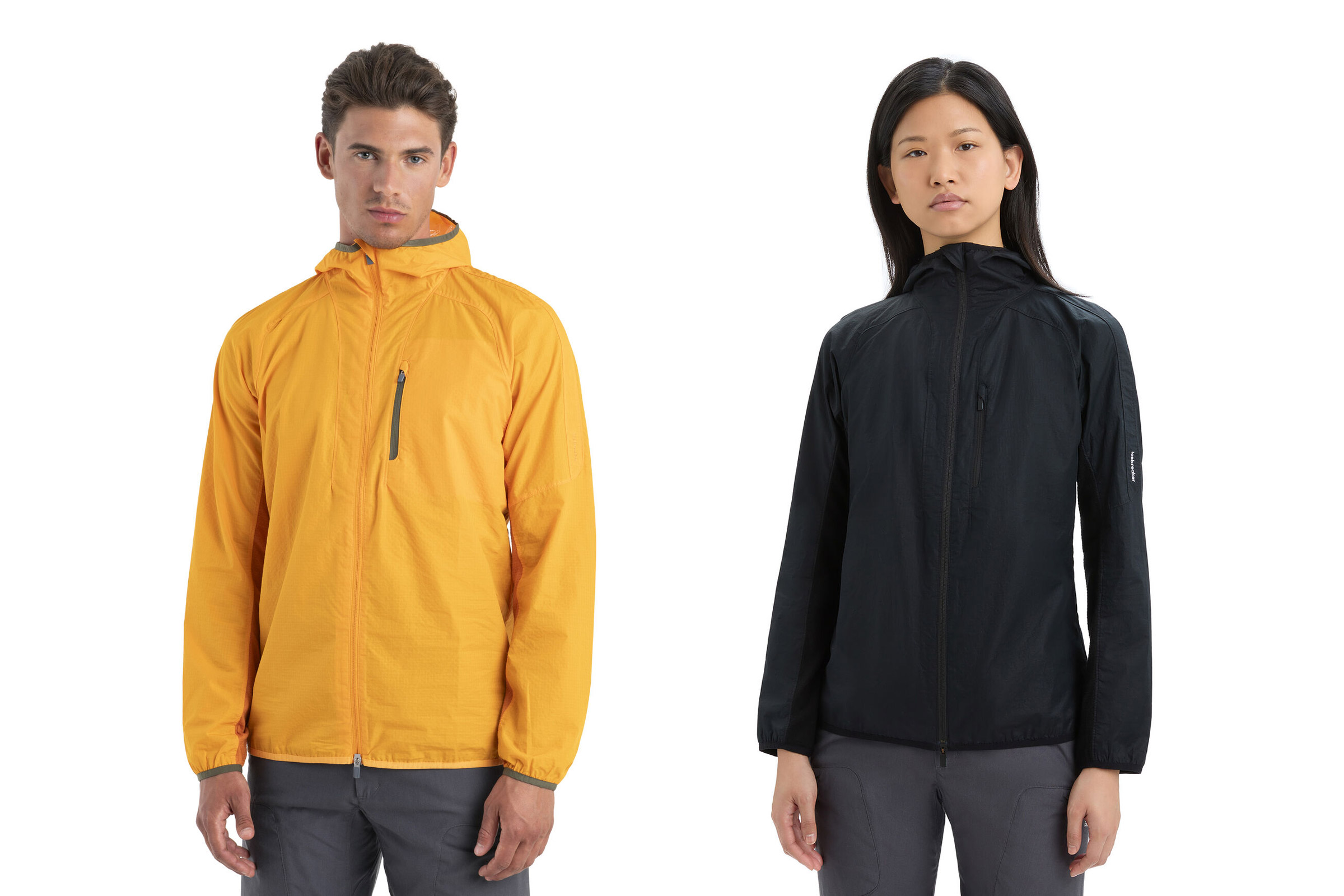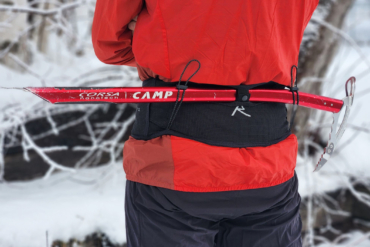Plastic is everywhere. It’s in our kitchens, in our clothing, in the clouds above our heads, and even in our bodies. At this point, it’s essentially unavoidable. But lately, I’ve become interested (OK, maybe a little obsessed) in cutting down on the amount of plastic I use daily, especially when it comes to apparel.
That’s why the Icebreaker Shell+ windbreaker caught my attention. While almost all outerwear is made from synthetic textiles, this layer is crafted entirely from cotton and merino wool treated with a water-repellant PFC-free durable water-repellent (DWR) finish. I loved the brand’s merino running shorts. They’re by far the best running shorts I’ve ever worn. So I decided to give the Shell+ a try.
Dig around in your drawers or gear closet and pull out a few jackets, base layers, or performance T-shirts. Most of these items will be made from petroleum-based fabrics like nylon and polyester. These materials are especially common for technical performance apparel because they’re durable and breathable, and they don’t soak up water. But they also shed microplastics and require lots of fossil fuels to produce.
It’s the great irony of outdoor apparel: Most of the gear we use to enjoy the outdoors is contributing to the degradation of our planet.
Icebreaker was founded in response to this problem. Since its launch in 1995, it has pioneered a more sustainable approach to technical outdoor apparel. It minimizes its plastic use by relying on natural fabrics like merino wool instead. If you think natural fabrics can’t measure up to synthetics in technical outdoor situations, the icebreaker Shell+ might make you reevaluate that stance.
In short: After a few days of testing in chilly and wet Michigan fall conditions, the Shell+ jacket impressed me. It’s a capable, lightweight layer that’s ideal for cold-weather hiking and running. The windproof material cuts cold air, while the water resistance provides just enough protection to keep you dry in a very light rain. The natural merino-cotton blend of the Shell+ proves that natural fabrics can make technical apparel too.
- Main fabric: 100% cotton with PFC-free DWR finish
- Mesh fabric: 100% merino wool
- Pockets: 1 chest pocket
- Verified weight: 9.4 oz., men’s size medium
Pros
- Feels light and flexible, doesn’t restrict movement
- Breathes well
- Chest pocket holds a phone
- Cuts down wind and blocks light precipitation
- Double zipper front allows you to get more venting if you need it
Cons
- Expensive
- Won’t protect you from steady or intense rain
- Zipper is hard to open when wearing gloves
icebreaker Shell+ Windbreaker Review

Fit and Feel
The Shell+ jacket is designed to be a lightweight layer for protection from wind and mild rain during high-intensity activities. When I pulled mine out of its packaging, I was surprised at how familiar it felt — the DWR-coated cotton fabric has a smooth texture similar to the synthetic windbreakers and rain jackets I’m used to.
It’s paired with merino wool mesh in key areas: Long strips under the sleeves from the armpits to the cuffs, and another long strip running vertically down the back of the jacket. The merino has a super-soft, comfortable texture, and it also adds some stretchiness to the jacket.
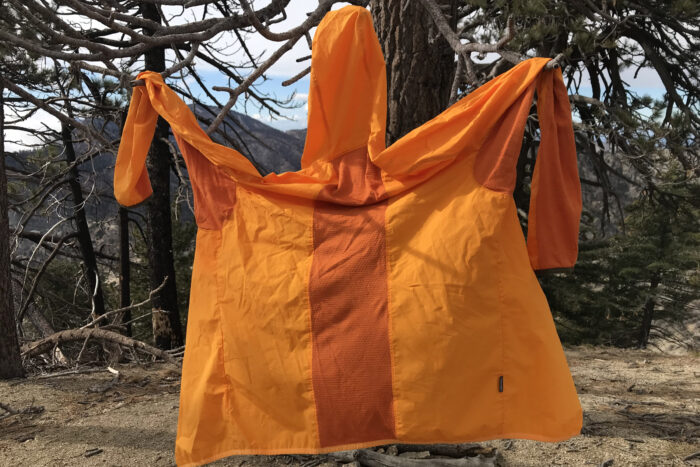
I tested my jacket on several short runs on neighborhood trails while visiting family in Michigan over Thanksgiving. Even just a few steps into my first test jog, the Shell+ impressed me with its lightweight feel and flexibility.
The flexible Merino mesh panels and raglan sleeves gave excellent freedom of movement. I could swing my arms freely as I ran and the jacket’s streamlined fit kept it from blowing around in the wind or feeling bulky. The elasticated cuffs kept the sleeves in place over my gloves, and the form-fitting hood didn’t blow off or flap around.
At 9.4 ounces for a men’s medium, it’s certainly not ultralight. In fact, at that weight, it is heavier than every one of the windbreakers on GearJunkie’s Best Windbreakers of 2023 roundup. The average weight on that list is 4.16 ounces, and many of the jackets included are less than 2 ounces. That is one of the great benefits of synthetic fabric: it is light. On that front, naturally based alternatives are still catching up.
But even at 9.4 ounces, the Icebreaker Shell+ never felt heavy or overly cumbersome. Its weight didn’t slow me down.
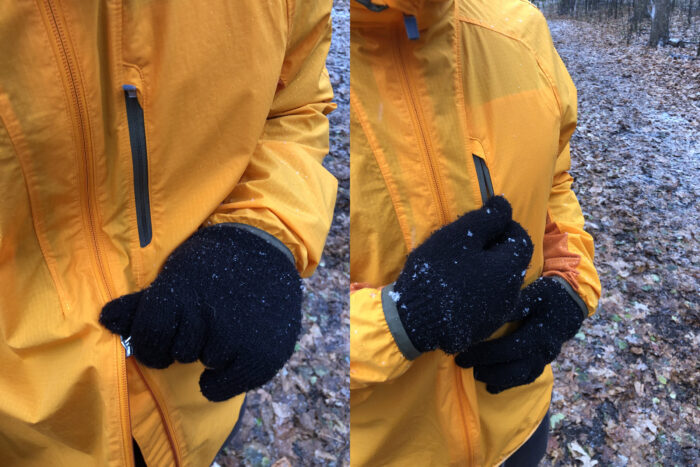
The zippered chest pocket had plenty of space for my phone. Despite some minor jostling, it stayed secure and I didn’t notice it too much while running. However, that is the only pocket on this jacket. There are no side or internal pockets.
The overall fit and feel of the Shell+ felt spot on. The jacket felt as though it disappeared on my body once I started moving. For performance outerwear, there’s no higher compliment.
Breathability

During my testing, temperatures ranged from the high 30s to the high 40s. The Shell+ seemed ideally suited for running in that weather (I paired the jacket with a technical base layer underneath, as well as a beanie hat and gloves).
I always appreciate running jackets that have vents to dump heat. And the merino mesh panels did a good job of shedding excess warmth while I was running. As I warmed up, I unzipped the front zipper at the top and bottom to create more airflow, and that kept me comfortable.
At the end of my test runs, I did notice some light moisture buildup due to sweat around the back of my shoulders. But overall, the jacket felt great while I was moving. Apparel designed for high-intensity activity has to strike a difficult balance between warmth and breathability. I’d say the Shell+ nailed it: It cut down the wind and chill, but it also breathed well. So, I never felt like I was roasting.
Weather Performance
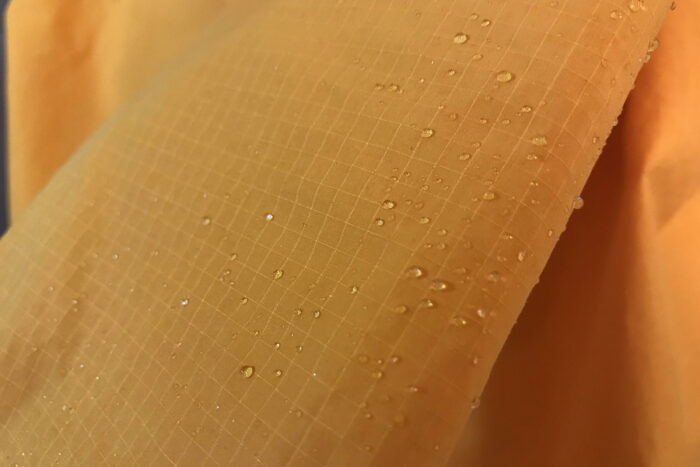
Icebreaker doesn’t claim the Shell+ is waterproof — only water repellant. Even so, it performed well in light precipitation in mild temperatures.
I wore the Shell+ over a base layer for a run on a 40-degree day with light, steady rain. While I was comfortable throughout my route, it didn’t block the water entirely. I noticed some mild dampness on my base layer once I made it home. But the DWR finish caused most of the rain to bead up and roll off the exterior of the jacket. I didn’t get totally soaked, which is impressive in a cotton-based jacket.
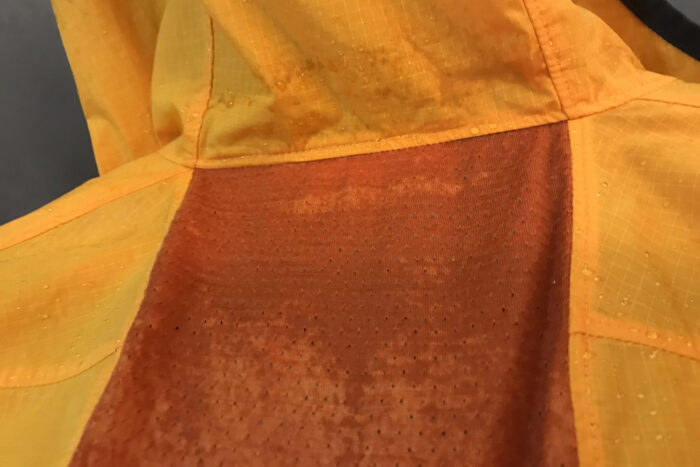
But how would it hold up during a storm? To simulate a downpour, I tested the Shell+ for a few minutes under a shower head at full blast, and, predictably, this was where the jacket reached its limit.
I didn’t experience any leaks at the front zipper (a storm flap at the back kept water out). But my base layer got soaked on the arms, and water rolling off the hood entered the wool mesh on the back and soaked my back as well. No surprise here: For heavy downpours or long runs in steady rain, you’ll need a fully waterproof jacket to stay dry. The Shell+ would be great under a rain jacket.
Room for Improvement
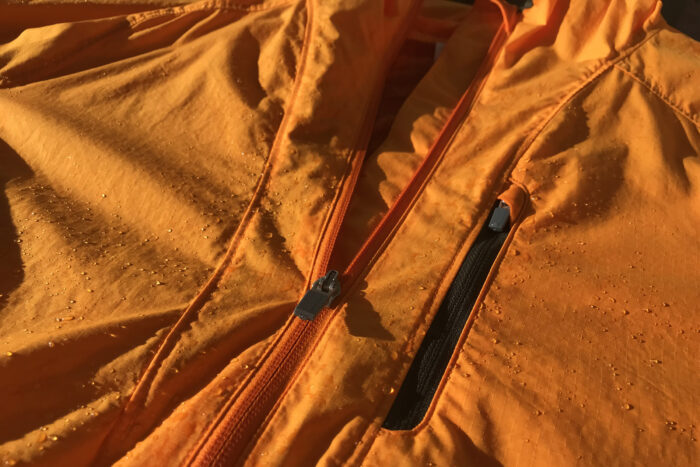
My biggest gripe with the Shell+? The front zippers. I found the jacket annoyingly difficult to zip open or closed while moving. The bottom zipper was especially stubborn, and I had to use both my hands (one to hold the hem of the jacket steady, one to yank on the zipper) to get it open for more airflow.
The zipper pulls are also quite small. So it was difficult to get a good grip while wearing gloves. Every time I tried to unzip my jacket, it devolved into an awkward two-handed operation that required me to slow down and take my eyes off the path in front of me. Not ideal while running.
The elastic hem on the Shell+ worked fine during my test runs, but I think a drawcord hem could be a good addition to this jacket. That way, in very windy conditions, you can cinch it down tight to prevent it from blowing around and letting in cold air.
And it would be remiss not to mention the weight of the Shell+. At 9.4 ounces, it is on the heavy end of windbreakers.
icebreaker Shell+ Windbreaker: Conclusion
The Shell+ makes a compelling alternative to synthetic windbreakers. While it won’t replace a waterproof jacket, it offers a comfy fit and great breathability, and I think it’s a stellar choice for chilly runs or hikes in dry to mildly wet weather.
Cotton and wool might sound like an odd combo for outerwear, but the Shell+ proves these natural materials can measure up to their plastic-based competitors. For those who want to reduce their use of plastics (and aren’t worried about keeping things ultralight), this jacket is a solid midlayer option.

